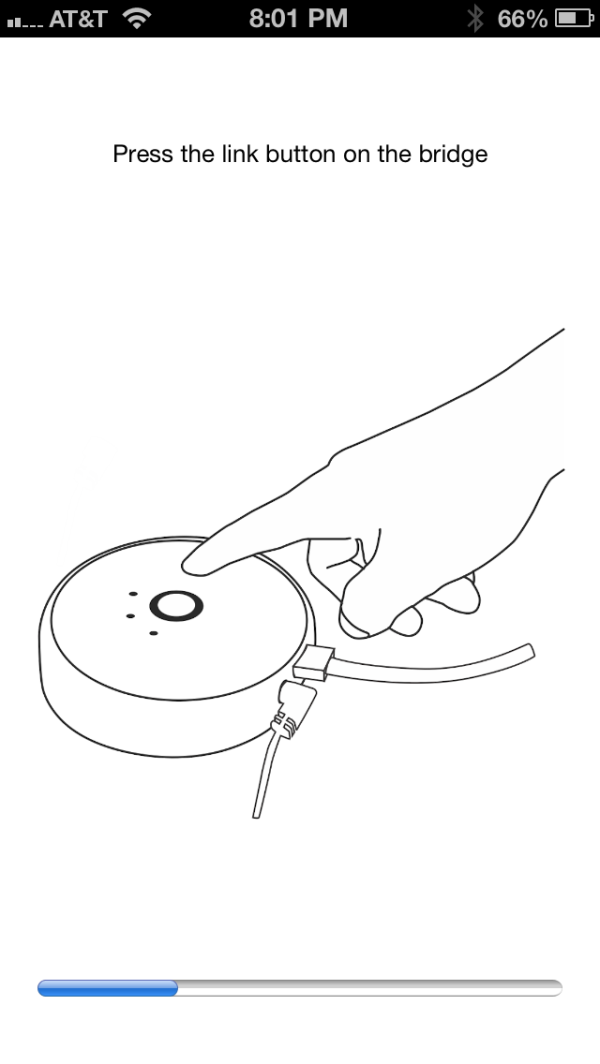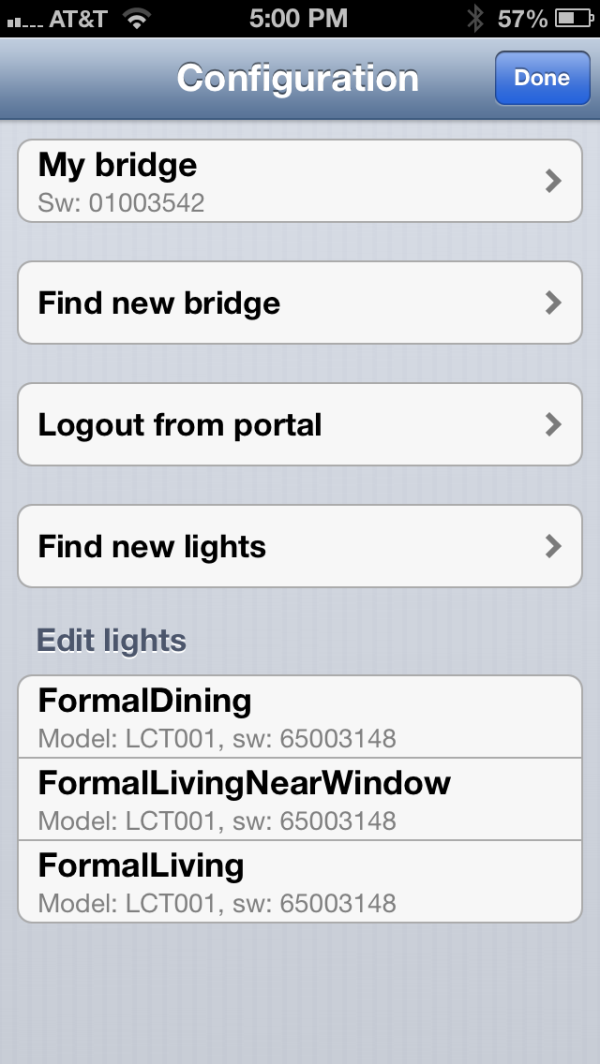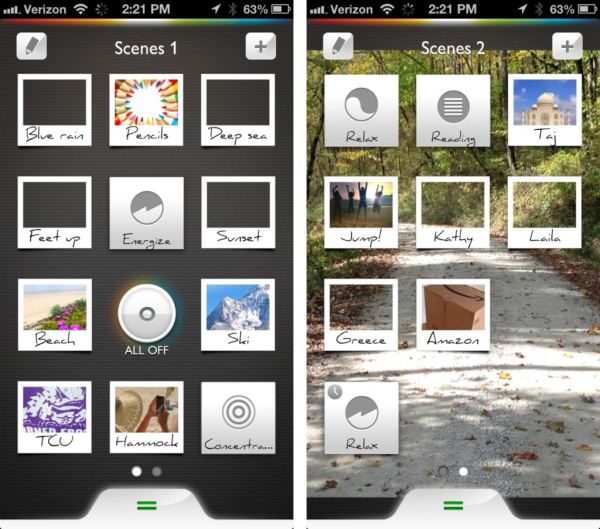Philips Hue: Automated Home Lighting Gets Colorful
by Ashu Joshi on March 1, 2013 12:50 AM EST- Posted in
- Gadgets
- Home Automation
- Philips
- Hue
- Lighting
Philips Hue Setup
The setup process is very easy and at no point do you need a PC or a Mac computer—everything can be done using a Smartphone or a Tablet. The first step for any automation controller that can be controlled over the Home Network or Internet is to get it on the Network, naturally. Philips makes this easy by sticking with Ethernet for the Hue Bridge.
As far as the setup procedure, the first step is to screw in the Connected Bulbs and turn them on. All the bulbs turn on just like normal light bulbs, with a default white light. Once all the bulbs are screwed in and powered on, plug the Hue Bridge into an Ethernet port connected to your home router/gateway and apply power.
The Hue Bridge boots in less than 20 seconds (you can see the boot process in this short video). The next step is to install the app from the Apple App Store on your iOS device (or the Google Play Store for Android).At this point, make sure that your smartphone WiFi is on and connected to your home network. Fire up the app and it will instruct you to press the “link” button on the controller. When you press the button the app discovers the Hue Bridge and you should be ready to go. In my case, it automatically discovered all the three bulbs and they showed up in the app.
From the App settings section it’s possible to rename each bulb to give it a meaningful location. To help with this process, when you select one of the bulbs in the app the corresponding physical bulb starts blinking to show you which light you’re adjusting. This is a handy feature for the initial setup, and it could be even more important if you happen to have a lot of Connected Bulbs.
The app comes with multiple scenes that set the lighting ambience to predefined levels. You can also snap a photo and let the app decide on the appropriate color(s), and you can save all of these settings to new “scenes” (e.g. you might have one setting for a regular dinner with a different settings for a “romantic dinner”). There is also an option in the app to add more Bridges or bulbs, but I have not been able to try that yet. It seems pretty straightforward: adding a new bulb takes you to a page on the Smartphone that instructs you to screw in the new light, turn power on, and start the search.
It’s also possible to control Hue from more than one device (e.g. a tablet, a phone, and maybe the phone of a significant other). The process is as before: download the app, make sure you are on the home network (WiFi), fire it up, and when the app prompts press the “link” button on the Hue Controller and it is paired to the network. (This works very similar to the Sonos app as well.) If you have edited the names of the bulbs (for example I called one of them “FormalDiningLamp”), the other devices will pick up the names as they’re all stored in the Hue Bridge (so thankfully you only have to input the names once).
Controlling the Bridge locally is pretty simple, but if you want to be able to manage the lighting when you’re not at home (e.g. you’re not connected to your home network), you’ll need to create an account on MeetHue.com. Select the “Login to portal” option within the app and it will open up a browser with the account creation page. The page is clearly designed for phones and tablets and after a few guided steps you should be all set. Once you confirm whether you’re using a smartphone or a tablet you can then control the lights from anywhere with Internet access (provided of course that your home network stays up).













94 Comments
View All Comments
degobah77 - Friday, March 1, 2013 - link
I think I understand your concern. Yes, to have full remote control at all times, the switch for the lamp needs to be in the ON state. But if you just need a quick light but don't want to bother with using the app, you can just use them like a regular bulb, instant on, instant off.I do this quite a bit in the morning. But, I could just as easily schedule some on and off times that coincide with my routine.
darkcrayon - Wednesday, March 6, 2013 - link
Right, if you just want the light on NOW, you could just flick the switch off and back on again and it would turn on in regular "incandescent emulation" mode. It's only the other scenario that would be annoying, if you wanted a light off NOW, so you flick the switch, but later on you'd have to go back and turn it on. Luckily though i can think of far fewer reasons i'd want to turn a light off urgently. (and i have other much quicker ways of remotely turning off the lights than the philips app - through a computer web interface or in some cases i have them set to turn off when my phone (and hence me) move out of my home out of bluetooth range).georgewedding - Friday, March 1, 2013 - link
1. What color temperature settings (degrees Kelvin) are supported? Can users set the bulbs for 6,500K, 5,000K or 3,2000K color temperature?2. Do the bulbs maintain these color temperatures when dimmed? What about as the bulbs age? And what is the projected lifespan of the bulbs?
3. What is the lumens output?
4. What is the resulting illumination level falling on a surface (lux) if the bulb is installed in standard( 8-foot) ceiling fixture?
5. What is the base style? A19? Are the bulbs spots or floods? (They appear to be flood lights). What is the beam spread at an industry standard installation height?
degobah77 - Friday, March 1, 2013 - link
Personal accent lighting. Read the other comments. This isn't a commercial product.aguilpa1 - Friday, March 1, 2013 - link
2 hune dolla!..., fo three bulb...no.I am as mad as hell - Saturday, March 2, 2013 - link
When is this current thingy going to be replaced by Disqus or something similar?This Guy - Saturday, March 2, 2013 - link
Are you sure this guy is a network expert Anand? I'm just a lowly pass average elec eng undergrad and even I know that zigbee supports multiple mesh networks in the same area on the same frequency. When you configure a zigbee mesh deivce you give it a network number. The radio then ignores or relays messages for other networks (depending on the radio's configuration).Zigbee is a low bandwidth, 2.4 GHz protocol. It is designed to ensure data is received. Xbee Pro modules (one implimentation of Zigbee) can send coherent line of sight signals over more than a mile.
Quote:
What isn't clear is whether or not you can increase the total number of devices by adding additional Bridges to the location. Given the use of the ZigBee controller along with the fact that there is no configuration on a per device level to connect it to the network (e.g. you just buy additional bulbs and they apparently broadcast and communicate with any and all Hue devices), we would assume that 50 lights and a single Bridge is about as far as you'll be able to go within a single area. Conceivably, there could also be problems if your immediate neighbor also picked up a Hue—how would the lights know to talk to your Hue network and not his? This is both the blessing and curse of going with an easy to configure technology.
Stuffster - Saturday, March 2, 2013 - link
After reading about these bulbs (closer to 50W each according to the math), my first thought was: what, if anything, can Philips/Google/Apple/whoever glean from my use of the app ?Are any/al of the changes I make in the app visible to these companies (or anyone listening in, such as the NSA :-))? Up till now it's only my electric company that has been remotely in the loop on such things.
I'd be particularly concerned about this when in wifi mode, where I'd expect that no data would need to exit my home. What's the scoop?
chstamos - Saturday, March 2, 2013 - link
There is a kickstarter project called "LIFX" that is based on the same basic principles (although their bulbs are supposed to utilize wifi, not zigbee). Unfortunately, judging from the "pledges" they don't seem to be much cheaper. Though, on the bright side (gettit? gettit? ;-) ) they seem to offer notifications via blinking home lights, and that's pretty nifty.....darkcrayon - Wednesday, March 6, 2013 - link
You should be able to get your hue lamps responding to whatever as well, there may already be implementations of that using the hacked protocol they use - at least anything a computer can script can control the lights. But yeah you're right, i looked at LiFX but they aren't any less expensive than Hue, and Hue is actually available...